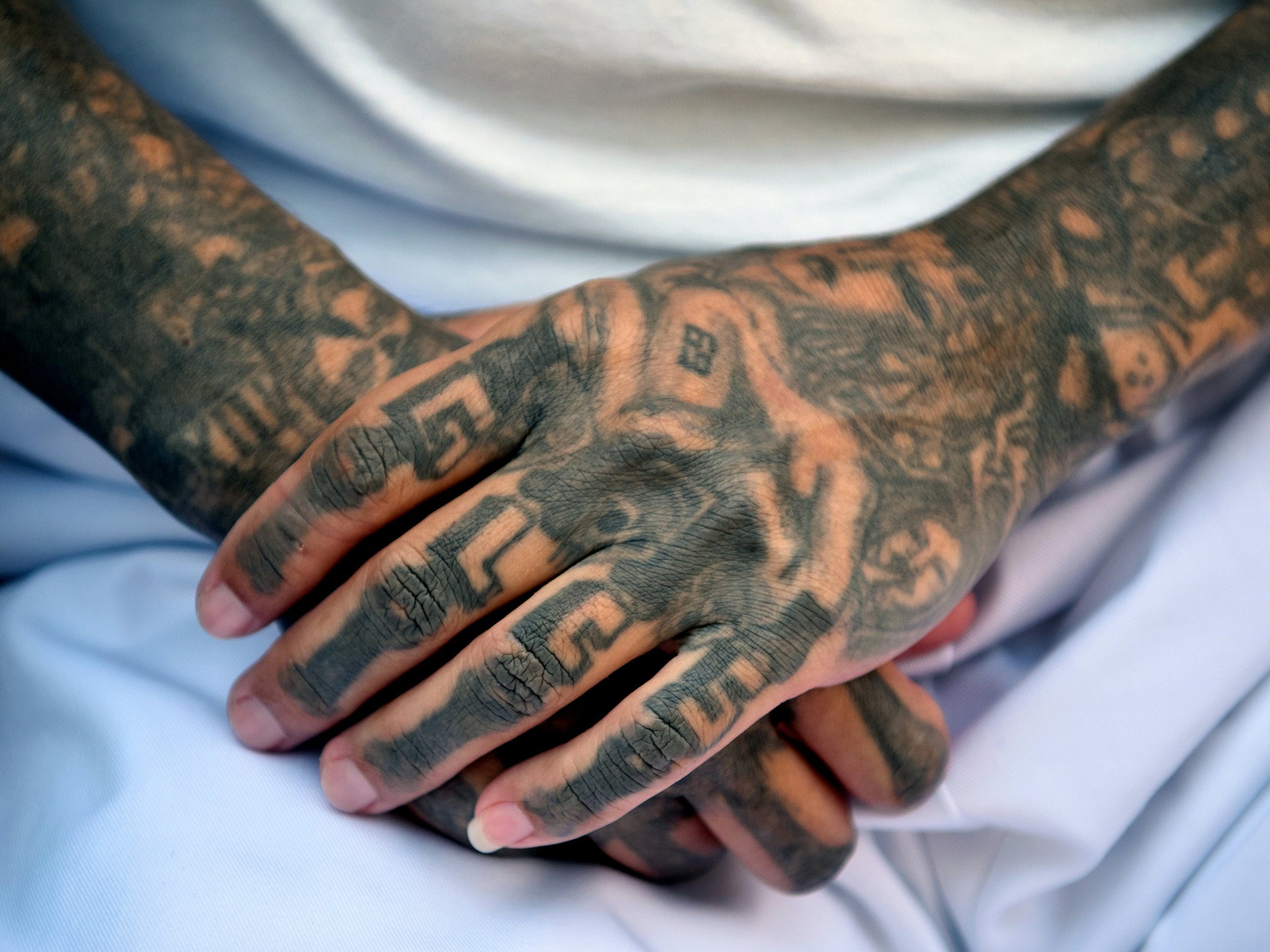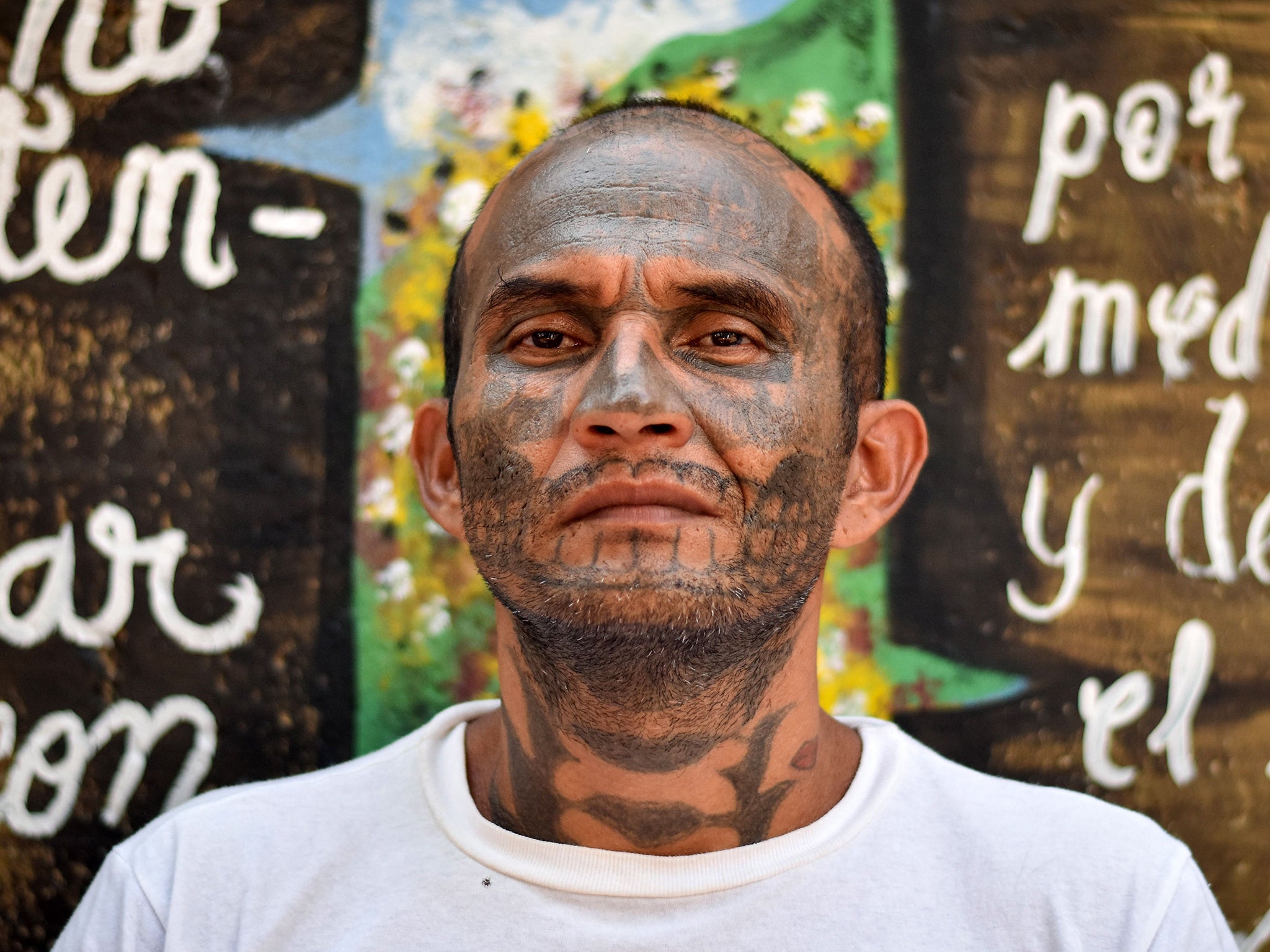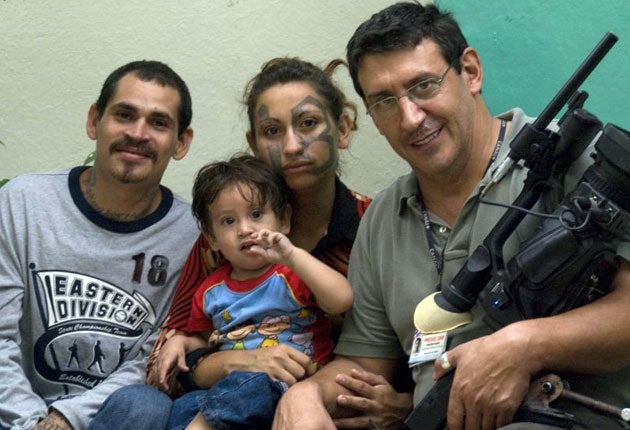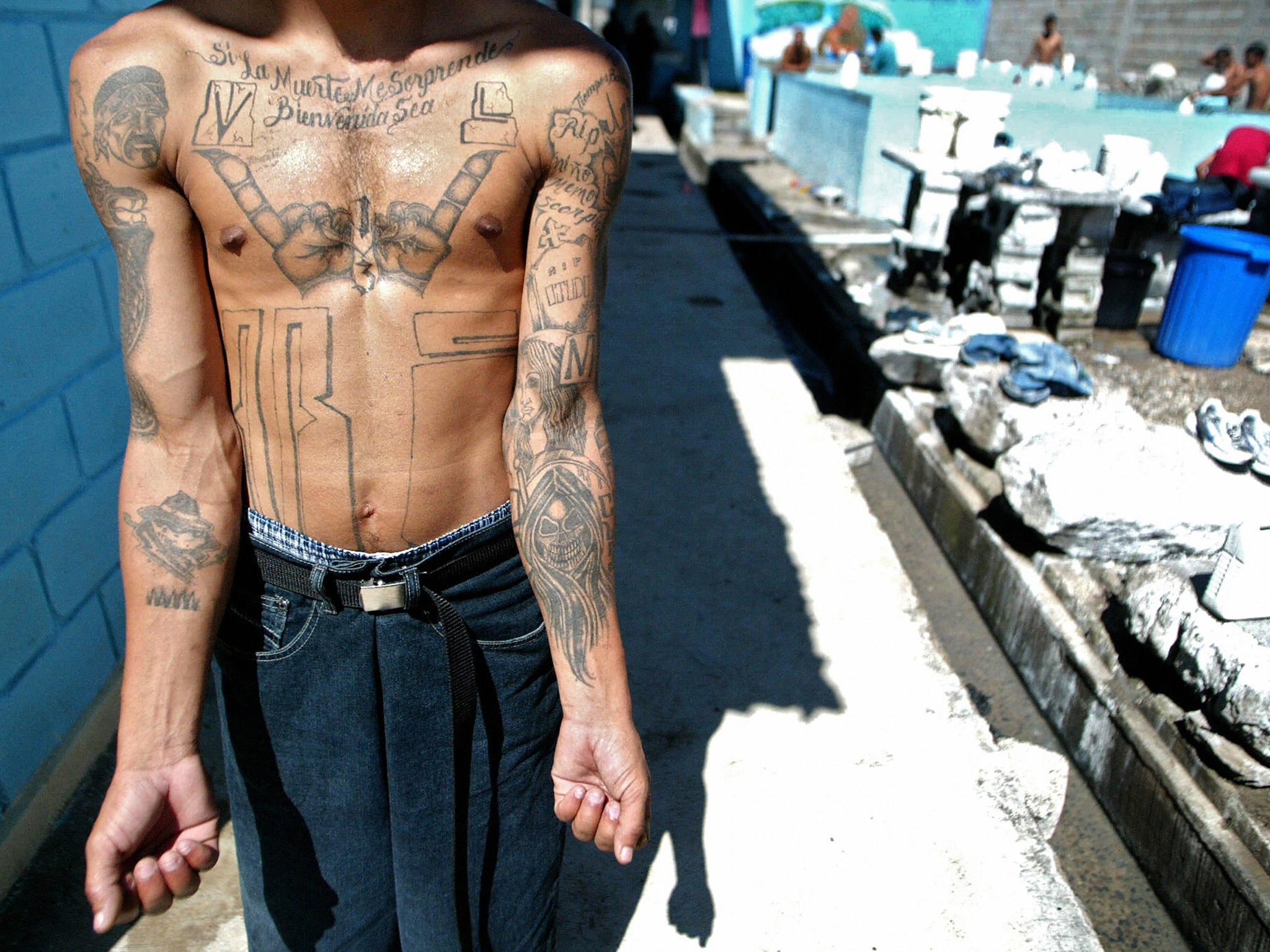How one man spent a year with MS-13 and lived to tell the tale
‘See, hear, and shut up’ is MS-13’s sacred code. Juan José Martínez d’Aubuisson saw and heard but did not shut up. Indeed, this Salvadorian anthropologist has written a book about the year he spent with the world’s most infamous gang. He talks to Andy Martin


It was Juan José Martínez d’Aubuisson’s first day as tutor to a bunch of young kids in El Salvador. To break the ice he decided to play a game with them. Off the top of his head he came up with Cops and Robbers. They had to split up into groups. It didn’t go too well because they all wanted to be Robbers.
D’Aubuisson was working, at the time, in a “youth centre” in the suburbs of San Salvador that doubled as the base for a “clica” or cell of MS-13, probably the most violent gang in the world. He is a Salvadoran anthropologist, now 33, who became embedded with this group, known as the Guanacos Criminales Salvatrucha, and has now written a book, A Year Inside MS-13: See, Hear, and Shut Up.
“See, hear, and shut up” is the strict gang protocol, subject to severe sanction. D’Aubuisson saw and heard, but did not shut up. Valour has scored over discretion. The last I heard, the book is not posthumous. And it reads more like a highly articulate diary, a vivid record of lived experience, than a scholarly tome.
El Salvador is ranked among the world’s most dangerous countries. In 2015, a reported 6,657 people were “violently killed” (104 per 100,000 inhabitants, compared with the UK’s 1).
The history of the Mara Salvatrucha is woven into the tangled relationship between North and Central America. The closest I’ve ever come to being killed in a bar was in San Salvador, back in the 1980s, at a time of political insurgency against the regime, backed by the United States. On the basis of being the only tall, blond, blue-eyed, English-speaking guy for miles around I was identified as a CIA agent, and told by a group of Salvadorans armed with machetes that I was about to be taken out and executed (rather painfully, was my impression).
I had, in effect, been caught in the cross-fire between quasi-Marxist “freedom movements” and military repression. A lot of Salvadorans in a similar position, together with ex-guerrillas, fled to the US, where many of them ended up in Los Angeles. And jumped out of the fire of civil war into the frying pan of gang warfare. In a culture governed by gangs, it is hard not to either join them or form a gang of your own.
The Mara part of their name comes from marabunta, a word meaning a crowd of friends or a collection of strangers and – in a Charlton Heston movie, The Naked Jungle, which was a hit in El Salvador – millions of swarming ants that you are struggling to overcome. Salvatrucha was the word that came to signify Salvadoran identity on the mean streets of LA. MS-13 was forged in the American prison system where the “13” – standing for the 13th letter of the alphabet, M – was synonymous with the Mafia.

So it emerged in the US, but when, under President Reagan, a lot of ex-convicts were deported back to El Salvador, MS-13 took root and flourished in the desolate postwar urban landscape, riven by territorial disputes, arbitrated by guns and grenades, “a country of orphans, of the unemployed, the crippled and maimed.” Soon hundreds of young men would be tattooed with “the two letters” and would live and die according to the law of the gang.
The rival gang is Barrio 18 (also known as Mara 18). A 1988 party that ended in a shoot-out sees a turf war between them and an escalating cycle of violence that is perfectly encapsulated in d’Aubuisson’s account of his year. He is initially taken under the wing of a polite veteran gang member and temporary leader, El Destino, who spends a lot of his time baking bread. The book culminates with a lot of people being baked to death in an atrocity that tops anything seen here before.
Down at the bottom of the hill lives Barrio 18. MS-13 occupies the top of the hill. D’Aubuisson has to hop on an ancient motorbike to get through enemy territory (and faces an existential crisis one day when his bike conks out). Aside from trying to stay alive, d’Aubuisson faces another dilemma, common to all anthropologists: the risk of going native and getting drawn into the culture he, in a more detached scholarly way, is trying to describe. He obeys the rules of not staring at anyone else’s tatts or ever mentioning the number 18. He doesn’t pick up a gun but he does put on some boots to participate in a football match on the MS-13 side, scared because it’s February 18 – anything to do with 18 or 18th is automatically seen as ill-omened.
The “youth centre” is taken over but the gang members really are youthful. You’re a veteran if you’re in your twenties. A kid called Hugo, aged 12, is one of El Destino’s protégés. His mother is desperately trying and failing to keep him out of the gang’s clutches. The recruits or “novices” get younger and younger and there is even a legend of a newborn – known as the “Chosen One” – who has never known any other kind of life. They all have cool nicknames: Dark, El Maniaco, El Noche, and Little Down, the hitman. For all of them, it seems as if there is nothing beyond the gang. Within their community they have celebrity status and a purpose.
The business model is simple: like a quasi-local government, they charge local businesses a “tax” or “rent”. In return there is a measure of protection (counter-balanced by the risk of incurring the wrath of the other guys). They also have to pay out for the wives and girlfriends of gangsters who have been put away. They don’t seem to be trading in any commodities (such as drugs). Gang economics appear marginal at best. But there is an overriding tribal logic at work. Gang members give each other the “Salvatrucha claw” – a sign of belonging.

Killing is a form of initiation, a blood oath. Only the first time is hard, after that it gets easy. “Each day one can peer more deeply,” d’Aubuisson writes, “and realise that for these young men there is honour in barbarity, bravery, and sacrifice, and that it is only the cause — their name for war — that makes life worth living. For this made-up cause, an army of young men kill each other, catching thousands in the crossfire.” Maximum brutality is not a means to an end but rather the raison d’être of the gang.
Little Down, their chief assassin, is described, appropriately enough, as a “harbinger of death”. His tattoos register the number of hits. But he is eager to boast. “I dressed up like a clown once too, man. Ha! Bro, but just to kill some dumbshit. Fuckin’ face paint and all, I went, and the dude’s like, ‘Hey, look, a clown!’ Then he hesitates a sec, and looks at me, and I just tell him, ‘Later, bro’ and BAM! BAM! BAM! He took like 10 gunshots to the face. I left that dumbass in the street.”
A favoured strategy is luring out a rival gang member using “bait” ie a woman. MS-13 is patriarchal and heteronormative. You can be killed for being a “faggot”: “Yeah, a faggot! If you’re fucking a dude, you lower your prestige, and the gang’s too.”
The dude’s like, ‘Hey, look, a clown!’ Then he hesitates a sec, and looks at me, and I just tell him, ‘Later, bro’ and BAM! BAM! BAM! He took like 10 gunshots to the face. I left that dumbass in the street
The clica starts to come apart when a neighbourhood carpenter is gunned down – four bullets in the face – for the reason that he is believed to be sleeping with the girlfriend of one of the gangsters who is in prison. A Tarantino-worthy succession of tit-for-tat killings soon follows. There is no more tutoring or baking. A bus driver is shot, which breaks the pact – the bus routes are supposed to be inviolable, a kind of no man’s land. Next a bar full of people watching a football game on television is sprayed with bullets. Around this time Little Down becomes leader of the pack, which is only logical – because he is the greatest psycho.
Buses get increasingly drawn into the war, with El Maniaco or others riding along by way of protection. Finally one bus, loaded with passengers, is intercepted by the Columbia Little Sycos – the clica of Barrio 18. A man gets on and douses the passengers with petrol. He gets off again and sets it alight. Seventeen people die (and more are injured) in the resulting conflagration. Anyone who escapes is shot. One woman, Carlota, manages to bust open a window with her elbow and throw her two daughters out – they survive.
Both sides hate the cops, who therefore try to keep their heads down, but ultimately they are forced to intervene. Little Down and El Maniaco are captured after a shootout. There is a suspicion that Barrio 18 and the police have cracked a deal. Two cars loaded with gangsters drive up the hill and unload their guns into Dark’s house.

El Destino is arrested and finally assassinated. Little Down is killed by police. A few years after the events he describes, d’Aubuisson goes to speak to the girls who survived the massacre – and their mother who, despite being burnt and shot, is still alive. He brings a message from Fox, the Barrio 18 hitman with “Columbia Little Sycos” tattooed across his face, who set fire to the bus and has been sentenced to 466 years. He wonders if they can forgive him. The answer is that they can’t.
Life inside MS-13 is “poor, nasty, brutish and short”, but at least it isn’t “solitary” (as Hobbes argued life for those living outside society must be). El Destino and his ilk are outsiders, but banding together into something like an extremely brutal football team. They have their numbers not on shirts but tattooed all over their bodies. Your chances of long-term survival in a gang are not good. You can be killed in battle or murdered by your own side. Which is also true of passengers – fellow-travellers – in the gang (and explains why the fate of passengers in the bus is pre-eminent).
D’Aubuisson boldly follows in the footsteps of the likes of Diego Gambetta in his studies of The Sicilian Mafia and Mafia-like organisations (Codes of the Underworld) and Sudir Venkatesh in Gang Leader for a Day, based in Chicago. They all get right inside the gang so you start to feel as if you are part of it too. And perhaps you are. Gangsters are readers too. The paradox of the gangster is that, on the one hand, they don’t want to be arrested, on the other hand they really want everybody to know that they are bad guys and should be treated with due awe and respect.
Protection requires reputation, as Gambetta points out: “A mafioso could not run his business if he had to take action to establish his credentials at every transaction.” So they are torn between omertà and the desire for notoriety. More than usually brave (or foolhardy) anthropologists slip through the interstices of this ambivalence. Their testimonies are bound to seem increasingly familiar and recognisable. Perhaps they show what becomes of aimless and disenfranchised young men anywhere in the world. MS-13 is fast becoming an international brand, even now opening branches in Spain. Perhaps the gang is the primal form of collective living, at once stone-age and contemporary.
D’Aubuisson’s family is no stranger to violence. His uncle, Roberto d’Aubuisson Arrieta, was one of Latin America’s most notoriously brutal military officers and organised a Salvadoran death squad in the 1980s, dedicated to extra-judicial assassination (most notably of Archbishop Oscar Romero). According to The Washington Post, he “openly talked of the need to kill 200,000 to 300,000 people to restore peace to El Salvador”.
Needless to say, the mission to record gangland for posterity can blow up in your face. In 2008, the French film director and journalist Christian Poveda made La Vida Loca, an incisive documentary about Barrio 18. In 2009 he was driving in El Salvador when he was ambushed and shot four times in the head (one theory has it that he was killed by MS-13 members jealous of the attention their rivals were getting).

Juan José Martínez d’Aubuisson is now working on the biography of an ex-gang member and hitman, who is therefore seen as a traitor to the cause. I asked him if he didn’t fear for his life. He replied: “A man should always fear for his life, whether working on these issues or on others.”
And if anyone wants to know how I managed to escape more or less intact from that bar in Salvador City, the simple answer is: the kindness of strangers. Without Maya (who took pity on my halting Spanish) and Brando (her big brother and leader of the pack) I wouldn’t have lived to tell the tale.
A Year Inside MS-13: See, Hear, and Shut Up by Juan José Martínez d’Aubuisson is published this month by OR Books, New York
Andy Martin is the author of With Child: Lee Child and the Readers of Jack Reacher. He teaches at the University of Cambridge
Join our commenting forum
Join thought-provoking conversations, follow other Independent readers and see their replies
Comments